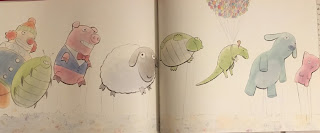Bolivar has been getting a lot of justly deserved attention. But he is not the first (fictional) dinosaur to find refuge in New York.
That would be - I think - Sinclair Sophocles, The Baby Dinosaur. Published in its author's and illustrator's home of Vienna in 1971 and published in English in the United States in 1974, Sinclair has Bolivar beat by over 40 years.
You might think that a lot has changed in 40 years, and a lot has. People lament the gentrification and write odes (through rose-colored glasses, in my opinion, possibly even hot-pink) to the gritty days of yore.
But some things never change.
In Sinclair Sophocles Friederike Mayrocker wrote, "You are probably wondering why the people in the street did not stare or scream when they saw a baby dinosaur walking by. I am wondering, too, but the fact is - no one did. People who live in cities are often like that."
Were truer words ever spoken (or written)? We New Yorkers pride ourselves on not staring - not at celebrities, not at crazy people, not at the strange outfits or the strange things people carry with them. Some people disparage this attitude as isolating. We prefer to see it as respecting people's privacy. Therefore people of all stripes, clothing and headgear- and dinosaurs - can ride the subway in peace.
 |
| Bolivar rides the subway undisturbed and unnoticed |
 |
| The Lizard form the Park rides the subway, undisturbed and unnoticed |
 |
| Man with giant red mouse ears rides the subway, undisturbed but noticed by me |
 |
| Shopping at Fairway, of course |
 |
| The 1 train does not stop here! |

 Bolivar is strikingly beautiful and detailed, leading to cries of recognition (Fairway! the subway tiles!) and the occasional calling out of an error (the 1 train does not stop at 81st St for the Museum of Natural History; that would be the B and C trains). There also some clever visual jokes, some New York-related (the local hot dog joint is the Papaya Czar rather than the Papaya King) and some not (Sybil's mom uses a Pineapple brand laptop (or perhaps Pomegranate)). The themes of friendship and when privacy becomes isolation, when anonymity turns into loneliness are treated with a light touch.
Bolivar is strikingly beautiful and detailed, leading to cries of recognition (Fairway! the subway tiles!) and the occasional calling out of an error (the 1 train does not stop at 81st St for the Museum of Natural History; that would be the B and C trains). There also some clever visual jokes, some New York-related (the local hot dog joint is the Papaya Czar rather than the Papaya King) and some not (Sybil's mom uses a Pineapple brand laptop (or perhaps Pomegranate)). The themes of friendship and when privacy becomes isolation, when anonymity turns into loneliness are treated with a light touch.But for my money, Sinclair Sophocles is the winner here. Both Bolivar and Sinclair are stories of a friendship between a child a dinosaur. Both are absurd, although Sinclair Sophocles ventures into the surreal with a talking furniture dust cover that renders the wearer invisible. But Sinclair elevates the theme of friendship with its beautiful ending, when Sinclair flashes his "promised sign" of forever friendship in the sky: the infinity sign.

 If we expand our search to include not just dinosaurs but reptiles in New York City more generally, we have Lyle the Crocodile who made his first appearance in 1962 in the classic The House on East 88th Street and Have You Seen My Dragon?, published in 2014. And in Chalk (2010) we have a playground structure shaped like a dinosaur coming alive in a city that, while not specifically New York, certainly could be.
If we expand our search to include not just dinosaurs but reptiles in New York City more generally, we have Lyle the Crocodile who made his first appearance in 1962 in the classic The House on East 88th Street and Have You Seen My Dragon?, published in 2014. And in Chalk (2010) we have a playground structure shaped like a dinosaur coming alive in a city that, while not specifically New York, certainly could be.And underlying it all is that old "alligator in the sewer" urban legend, which dates back until at least the 1930s. Steve Light, author and illustrator of Have You Seen My Dragon? notes that his father used to claim that the steam coming out of manhole covers was the breath of a dragon.
There is something about the intersection of the wild and the civilized and the line between privacy and isolation that fascinate us. Perhaps that is why the legend of the urban dinosaur, unlike the dinosaur itself, will never become extinct.






Nice piece! Congrats on 7 years!
ReplyDeleteThis is a great post, thanks for sharing it.
ReplyDelete